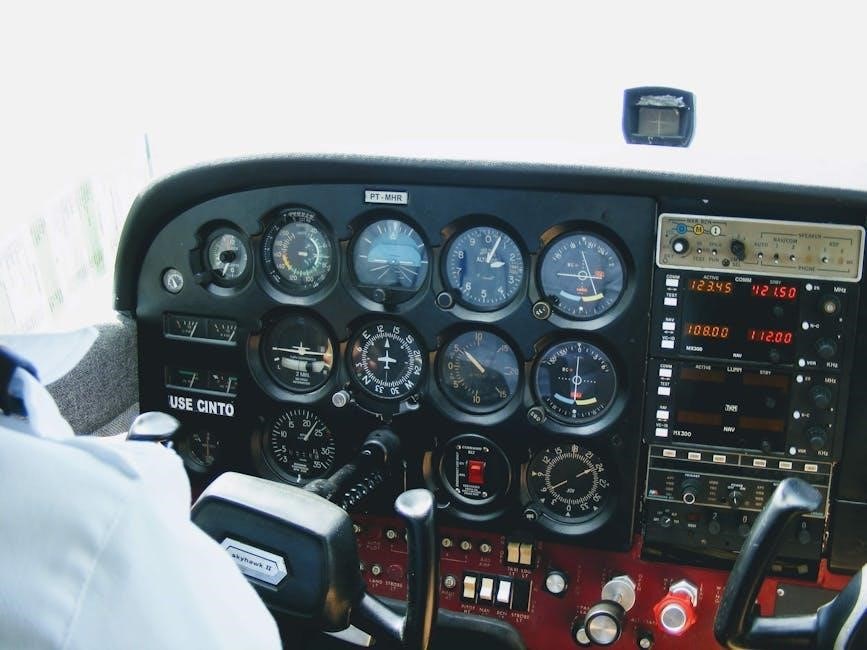2005 honda pilot owner’s manual
Welcome to the 2005 Honda Pilot Owners Manual, your comprehensive guide to understanding and maintaining your vehicle. This manual provides essential information on safety, features, and maintenance to ensure optimal performance and longevity of your Honda Pilot.
Overview of the Manual
This manual is a detailed guide designed to help you understand and maintain your 2005 Honda Pilot. It covers essential topics such as safety precautions, vehicle features, and maintenance schedules. Organized into clear sections, the manual provides step-by-step instructions for operating and caring for your SUV. From dashboard controls to troubleshooting common issues, it ensures you have the knowledge to optimize performance and longevity. Referencing this manual regularly will help you stay informed about proper vehicle care and safety practices, making it an invaluable resource for both new and experienced owners.
Importance of Reading the Manual
Reading the 2005 Honda Pilot Owners Manual is crucial for safe and effective operation of your vehicle. It provides detailed information about features, maintenance, and troubleshooting, ensuring you understand how to use and care for your SUV properly. By familiarizing yourself with the manual, you can avoid potential safety hazards, optimize performance, and extend the lifespan of your vehicle. It also serves as a reference for diagnosing issues and performing routine maintenance, helping you save time and money. Keep the manual handy to address questions or concerns promptly and confidently.

Safety Precautions
Always follow safety guidelines to ensure safe operation of your 2005 Honda Pilot. Understand warning lights, symbols, and emergency procedures to prevent accidents and protect occupants.
General Safety Guidelines
Adhering to general safety guidelines is crucial for safe operation of your 2005 Honda Pilot. Always wear seatbelts, ensure proper child restraint, and avoid distractions while driving. Familiarize yourself with warning lights and symbols, as they indicate potential issues. Regular maintenance, such as checking tire pressure and fluid levels, is essential for vehicle reliability. Never ignore safety warnings or postpone repairs. Follow manufacturer recommendations for parts and accessories to ensure compatibility and safety. By prioritizing these guidelines, you protect both your vehicle and its occupants, ensuring a safe and enjoyable driving experience.
Warning Lights and Symbols
Your 2005 Honda Pilot is equipped with a range of warning lights and symbols designed to alert you to specific vehicle conditions. The dashboard features indicators for oil pressure, battery charge, and engine temperature, among others. Understand each symbol to address potential issues promptly. Red lights typically signal critical conditions requiring immediate attention, while yellow lights indicate maintenance or system checks. Refer to the manual for detailed explanations of each light to ensure proper response and prevent potential damage to your vehicle.
Emergency Procedures
In case of an emergency, your 2005 Honda Pilot is equipped with features to help ensure safety. If the engine stalls, move to a safe location, apply the parking brake, and stay calm. For a flat tire, follow the same steps and refer to the manual for spare tire instructions. Hazard lights should be used to alert other drivers in case of breakdowns. In the unlikely event of a fire, evacuate the vehicle immediately and call emergency services. Always keep a first-aid kit and emergency contact information accessible. Refer to the manual for detailed emergency procedures to ensure preparedness and safety on the road.

Vehicle Features
The 2005 Honda Pilot Owners Manual details the vehicle’s key features, including exterior, interior, and technology systems, ensuring owners understand and utilize them effectively for optimal performance and comfort.
Exterior Features
The 2005 Honda Pilot boasts a robust exterior design with features like alloy wheels, roof rails, and fog lights for enhanced functionality and style. The exterior is built to withstand various weather conditions, ensuring durability and reliability. The side mirrors are designed for optimal visibility, while the front grille adds a touch of ruggedness. The rear spoiler improves aerodynamics, and the chrome exhaust finisher contributes to a polished look. The vehicle also offers a range of color options, including metallic finishes, to suit individual preferences. These exterior features collectively enhance the Pilot’s versatility, making it suitable for both urban and off-road adventures.
Interior Features
The 2005 Honda Pilot’s interior is designed for comfort and practicality, offering a spacious cabin with versatile seating arrangements. The three-row seating accommodates up to eight passengers, while the second-row captain’s chairs provide a more personalized experience. The interior features include air conditioning, cruise control, and a premium audio system for enhanced driving comfort. Storage compartments and cup holders are strategically placed throughout the cabin for convenience. The Pilot also offers a 60/40 split-folding second-row seat and a 50/50 split-folding third-row seat, maximizing cargo space when needed. These interior features ensure a comfortable and functional environment for both passengers and drivers.
Technology and Entertainment Systems
The 2005 Honda Pilot offers a range of technology and entertainment features designed to enhance your driving experience. The audio system includes an AM/FM/CD player with six speakers, providing high-quality sound throughout the cabin. For added convenience, steering wheel-mounted audio controls allow you to adjust settings without taking your hands off the wheel. Optional features like a navigation system and rear-seat entertainment package further elevate comfort and enjoyment. These systems ensure that both drivers and passengers stay connected, entertained, and informed on the go, making every journey more enjoyable and stress-free.

Instruments and Controls
The 2005 Honda Pilot features a user-friendly dashboard with essential instruments and controls. The instrument panel includes a speedometer, tachometer, and warning lights for vehicle status monitoring. Controls for climate, audio, and cruise functions are intuitively placed for easy access, ensuring a smooth and convenient driving experience.
Dashboard Overview
The dashboard of the 2005 Honda Pilot is thoughtfully designed for functionality and ease of use. It features a central instrument cluster with a digital display, providing essential information such as speed, engine temperature, and fuel level. Controls for the air conditioning, audio system, and cruise control are strategically placed within easy reach of the driver. The dashboard also includes warning lights and indicators to alert the driver of potential issues, ensuring safe and informed driving. This layout enhances the driving experience by allowing drivers to focus on the road while maintaining control over key vehicle functions.
Steering Wheel Controls
The 2005 Honda Pilot features a steering wheel equipped with convenient controls to enhance driver convenience. Located on the left and right sides of the steering wheel, these controls allow you to manage the audio system, cruise control, and other functions without taking your hands off the wheel. The left-side buttons adjust the volume and change tracks, while the right-side buttons manage cruise control settings, such as setting or increasing/decreasing speed. These intuitive controls ensure a safe and comfortable driving experience by keeping essential functions within easy reach, allowing you to stay focused on the road.
Instrument Panel Explanation
The instrument panel in your 2005 Honda Pilot is designed to provide clear and essential information at a glance. It features a speedometer, tachometer, fuel level gauge, and temperature gauge, ensuring you stay informed about your vehicle’s status. Warning lights for maintenance, seat belts, and ABS are also included to alert you of potential issues. The panel’s layout is intuitive, with gauges and indicators arranged for easy readability. This setup helps you monitor your vehicle’s performance and stay safe on the road. Refer to the manual for detailed explanations of each gauge and light to maximize your understanding and driving experience.

Maintenance Schedule
Regular maintenance is crucial for your 2005 Honda Pilot’s longevity. Follow the recommended schedule for oil changes, tire rotations, and fluid checks to ensure optimal performance and prevent issues.
Recommended Maintenance Intervals
Regular maintenance is essential for the longevity and performance of your 2005 Honda Pilot. The recommended maintenance intervals are designed to ensure your vehicle runs efficiently and safely. Oil changes are typically required every 5,000 to 7,500 miles, depending on driving conditions. Tire rotations should be performed every 6,000 to 8,000 miles to maintain even tread wear. Additionally, the manual recommends checking and replacing the air filter every 15,000 miles and inspecting the brakes every 12,000 miles. Following these intervals helps prevent mechanical issues and ensures your Pilot operates at its best. Always refer to the manual for a detailed schedule.
Oil Change and Fluid Check
Regular oil changes are crucial for maintaining your 2005 Honda Pilot’s engine health. Use 5W-20 synthetic oil for optimal performance. Change the oil every 5,000 to 7,500 miles, depending on driving conditions. Additionally, check the coolant, transmission, and brake fluids during each service. Ensure all levels are within the recommended ranges and top them off as needed. Always refer to the manual for specific guidelines and procedures. Proper fluid maintenance prevents overheating, wear, and damage to critical systems, ensuring your Pilot runs smoothly for years to come. Always use genuine Honda products for reliability.
Tire Pressure and Rotation
Maintaining proper tire pressure is essential for safety, fuel efficiency, and handling. Check tire pressure monthly and before long trips, using the recommended levels found in the manual or on the tire information label. Rotate tires every 5,000 to 8,000 miles to ensure even tread wear. Use the rearward cross pattern for rotation. Uneven wear can lead to reduced traction and premature replacements. Always inspect tires for damage or wear during rotations. Proper tire care enhances vehicle performance, safety, and longevity. Refer to the manual for specific guidelines tailored to your 2005 Honda Pilot.

Troubleshooting Common Issues
Identify and address common problems using diagnostic tools and guidelines in the manual. Check error codes, reset systems, and perform basic checks to resolve issues efficiently.
Diagnosing Common Problems
Diagnosing issues in your 2005 Honda Pilot begins with understanding error codes and warning lights. Refer to the troubleshooting section for specific codes and their meanings. Check the charging system, ignition, and starter for common electrical issues. For mechanical problems, inspect the air filter, belts, and fluid levels. Use the manual’s diagnostic procedures to identify faults in the cooling or braking systems. If issues persist, consult a professional or use specialized tools for advanced diagnostics. Always follow safety guidelines when inspecting or repairing your vehicle to ensure your safety and the vehicle’s proper function.
Resetting the Maintenance Light
To reset the maintenance light on your 2005 Honda Pilot, follow these steps: Turn the ignition to the “ON” position without starting the engine. Press and hold the “SELECT/RESET” button until the maintenance light flashes. Navigate to the maintenance light icon in the instrument panel and press the button again until the light turns off. Release the button and turn the ignition off. If the light persists, consult a professional or refer to the manual for additional troubleshooting. Regular resets ensure accurate maintenance tracking and prevent false warnings.
Addressing Error Codes
If your 2005 Honda Pilot displays an error code, it indicates a specific issue with the vehicle. Use an OBD-II scanner to retrieve the code and identify the problem. Common codes include issues with emissions, sensors, or engine performance. Refer to the manual or a repair guide for code definitions. Address the underlying issue promptly to prevent further damage. For complex problems, consult a certified mechanic. Ignoring error codes can lead to reduced performance or costly repairs. Always follow proper diagnostic procedures to ensure accurate troubleshooting and maintain your vehicle’s health. Regular checks can help catch issues early, avoiding major breakdowns.
For your 2005 Honda Pilot, follow manufacturer guidelines for repairs and replacements. Use genuine parts and refer to the manual for DIY tips or professional advice. For minor repairs on your 2005 Honda Pilot, consider DIY tasks like oil changes, tire rotations, and air filter replacements. Always use genuine Honda parts for reliability. Refer to the manual for step-by-step instructions and safety precautions. Simple fixes, such as replacing wiper blades or fuses, can save time and money. Ensure proper tools are used to avoid damage. For complex issues, consult a professional to maintain your vehicle’s performance and warranty. Regular maintenance is key to extending the life of your Honda Pilot. If you encounter complex issues beyond basic maintenance, consult a certified Honda technician. Problems like transmission faults, engine malfunctions, or advanced electrical system errors require professional expertise. DIY repairs on critical systems can lead to further damage or safety risks. For tasks involving specialized tools or diagnostic equipment, seek assistance from a qualified mechanic. Additionally, if your vehicle is under warranty, ensure repairs are done by authorized dealers to maintain coverage. Always prioritize safety and reliability by consulting a professional for major repairs or unfamiliar procedures. Your 2005 Honda Pilot is backed by a comprehensive warranty program designed to protect your investment. The warranty covers parts and labor for defects in materials and workmanship under normal use. Regular maintenance must be performed as outlined in the manual to maintain warranty validity. Honda-approved service centers are recommended for repairs to ensure compliance with warranty terms. Contact your local Honda dealer for details on warranty coverage, extensions, and service options. Keeping your vehicle serviced by certified professionals ensures optimal performance and protects your warranty benefits. Refer to the warranty booklet for specific terms and conditions. Optimize your driving experience with practical advice tailored for your 2005 Honda Pilot. Discover strategies to enhance fuel efficiency, ensure safe practices, and improve handling performance on various roads. To maximize fuel efficiency in your 2005 Honda Pilot, maintain proper tire pressure, drive at moderate speeds, and avoid excessive idling. Use cruise control on highways to reduce acceleration. Ensure regular oil changes and air filter replacements to improve engine performance. Plan routes efficiently to minimize unnecessary stops. Avoid heavy loads and remove unnecessary cargo to reduce weight. Keep your vehicle well-maintained, as a tuned engine consumes less fuel. By following these tips, you can enhance your Pilot’s fuel economy and enjoy cost-effective driving. Always wear your seatbelt and ensure all passengers do the same. Adjust mirrors and seats for optimal visibility before driving. Maintain a safe distance from other vehicles and avoid speeding. Use turn signals consistently to indicate your intentions. Stay alert and avoid distractions like using your phone while driving. Be cautious in adverse weather conditions, reducing speed and increasing following distance. Keep your vehicle well-maintained to ensure proper braking and handling. Never drive under the influence of alcohol or drugs. Follow all traffic laws and signs to ensure a safe journey for yourself and others. The 2005 Honda Pilot is designed for smooth handling and robust performance. Its responsive steering and stable suspension ensure precise control on various road conditions. The VTEC V6 engine delivers ample power for both city driving and highway cruising. Proper tire pressure and alignment are crucial for maintaining optimal performance. Regular maintenance, such as oil changes and filter replacements, ensures the engine runs efficiently. Avoid extreme acceleration or braking to preserve fuel efficiency and reduce wear on the vehicle. By following these guidelines, you can enjoy a balanced blend of power and reliability in your Honda Pilot. Your 2005 Honda Pilot is protected by comprehensive warranties covering parts, labor, and roadside assistance. Review the warranty booklet for details on coverage periods and conditions to ensure your vehicle remains protected and serviced appropriately. Your 2005 Honda Pilot is backed by a comprehensive warranty program designed to protect your investment. The warranty coverage includes repairs and replacements for parts and labor under specified conditions. It is essential to review the warranty booklet provided with your vehicle to understand the duration, coverage limits, and any exclusions. This document outlines the terms of your New Vehicle Warranty, Powertrain Warranty, and any additional protections. Familiarizing yourself with these details ensures you can maintain your vehicle’s condition and address any issues promptly. Always refer back to the manual for specific terms and conditions to avoid unintended violations of warranty coverage. The 2005 Honda Pilot warranty provides coverage for repairs and replacements of defective parts and labor under normal use. The New Vehicle Warranty typically covers the vehicle for a specified period or mileage, while the Powertrain Warranty offers extended protection for engine and transmission components. Additional warranties may include corrosion protection and emissions-related components. Understanding the coverage periods, mileage limits, and excluded items is crucial for maintaining eligibility. Regular maintenance, as outlined in the manual, is often required to uphold warranty validity. Refer to the warranty booklet for detailed terms and conditions to ensure your Honda Pilot remains protected throughout the coverage period. To file a warranty claim for your 2005 Honda Pilot, contact an authorized Honda dealership. Ensure your vehicle is within the warranty period and mileage limits. Provide proof of regular maintenance as outlined in the manual. The dealership will review your claim and determine eligibility for repairs or replacements under the warranty terms. Keep copies of all documentation, including maintenance records and claim submissions, for your records. Understanding the claims process and required documentation will help ensure a smooth experience. Refer to the warranty booklet for specific details on filing procedures and required information. Maintaining accurate service records ensures your Honda Pilot’s longevity and resale value. Keep all maintenance receipts and schedules organized for easy reference and verification. Maintaining detailed maintenance records is crucial for tracking your Honda Pilot’s service history. Record dates, mileage, and services performed to ensure compliance with the recommended schedule. Include receipts and notes from each visit for clarity. Store these records in a dedicated folder or digitally for easy access. This documentation helps verify the vehicle’s condition during warranty claims or resale. Regular updates ensure transparency and support the car’s long-term health. Accurate records also help prevent overlooked maintenance, ensuring your Honda Pilot remains reliable and efficient over time. Tracking your Honda Pilot’s service history ensures you stay informed about its maintenance and repairs. Use the manual’s maintenance log or a digital tool to record each service, including oil changes, tire rotations, and part replacements. Note the mileage and date of each service to monitor progress. This documentation helps verify the vehicle’s upkeep during warranty claims or inspections. Consistent tracking also aids in identifying patterns and potential issues early. By maintaining a clear service history, you ensure your Honda Pilot remains in optimal condition and retains its value over time. Regular updates are essential for accuracy and reliability. Preparing for inspections ensures your Honda Pilot meets safety and regulatory standards. Review the manual to understand inspection requirements. Check all essential systems, including brakes, tires, and lights. Ensure fluids are at recommended levels and address any recalls. Organize service records for review. Verify the Vehicle Identification Number matches documentation. Test all features to ensure proper function. A thorough inspection preparation helps identify and resolve issues promptly, ensuring compliance and maintaining your vehicle’s optimal condition. Regular checks also contribute to its longevity and reliability on the road. Thank you for reviewing the 2005 Honda Pilot Owners Manual. Proper maintenance and safe driving practices will ensure your vehicle’s longevity and performance. Refer back regularly for guidance. The 2005 Honda Pilot Owners Manual is a comprehensive guide designed to help you understand and maintain your vehicle effectively. It covers essential safety precautions, vehicle features, and maintenance schedules to ensure optimal performance. The manual emphasizes the importance of regular maintenance, such as oil changes and tire rotations, to prolong the life of your Honda Pilot. Additionally, it provides troubleshooting tips for common issues and guidelines for safe driving practices. By following the recommendations outlined in this manual, you can ensure your vehicle runs smoothly and safely for years to come. To ensure your 2005 Honda Pilot remains reliable and performs optimally, adhere to the recommended maintenance schedule. Regular oil changes, tire rotations, and fluid checks are crucial to prevent wear and tear. Keep your vehicle clean, both inside and out, to protect against rust and maintain its appearance. Avoid extreme driving conditions when possible, and address any issues promptly to prevent minor problems from escalating. Proper care and attention will extend the lifespan of your Honda Pilot, ensuring it serves you well for many years to come. Regularly referencing your 2005 Honda Pilot Owners Manual ensures you stay informed about best practices for maintenance, safety, and operation. It provides valuable insights to enhance your driving experience and prevent potential issues. By revisiting the manual, you can uncover tips for optimizing performance and addressing common concerns. This habit fosters a deeper understanding of your vehicle, helping you make informed decisions to extend its lifespan. Keep the manual handy and consult it often to maximize your Honda Pilot’s reliability and enjoyment for years to come.
Repair and Replacement Guidelines
DIY Repair Tips
When to Consult a Professional
Warranty and Service Options

Driving Tips
Optimizing Fuel Efficiency
Safe Driving Practices
Handling and Performance

Warranty Information
Understanding Your Warranty
Warranty Coverage Details
Filing a Warranty Claim

Service History and Records
Keeping Maintenance Records
Tracking Service History
Preparation for Inspections
Final Tips for Vehicle Longevity
Encouragement to Refer Back to the Manual